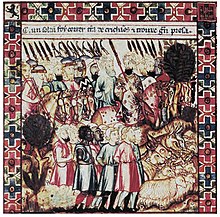
Back صقالبة (الأندلس) Arabic Сакалиби Bulgarian Saqaliba Catalan Saqāliba German Saqaliba Spanish Saqaliba French Saqalibah ID Saqaliba Italian サカーリバ Japanese 사칼리바 Korean
| Part of a series on |
| Forced labour and slavery |
|---|
 |







Saqaliba (Arabic: صقالبة, romanized: ṣaqāliba, singular Arabic: صقلبي, romanized: ṣaqlabī)[nb 1] is a term used in medieval Arabic sources to refer to Slavs, and other peoples of Central, Southern, and Eastern Europe. The term originates from the Middle Greek slavos/sklavenos (Slav), which in Hispano-Arabic came to designate Slavic slaves.
The Arabs had only a very vague notion of the ethnic characteristics of the populations with which they were not neighbors. It is likely that the term Saqaliba designated a disparate group of Balkan, Caucasian, Turkic and Slavic peoples living between the Baltic Sea and the Black and Caspian Seas. Ahmad ibn Fadlan, for example, describes Almis, king of the Volga Bulgars, as "king of the Saqaliba", while Al-Biruni calls the Baltic Sea the "sea of the Saqaliba".
The word was often used to refer specifically to Slavic slaves, but it could also refer more broadly to various other ethnicities of Eastern Europe traded by the Arab traders, as well as all European slaves in some Muslim regions like Spain and Portugal including those abducted from raids on Christian kingdoms of Spain and Portugal.[2][3] According to Sudár and B. Szabó, the word Saqaliba meant 'forest dweller', regardless of ethnicity.[4]
Saqaliba slaves, mostly young males, were taught the Arabic language and brought into the fold of Islam. These Saqaliba slaves filled military and administrative positions within Islamic empires, especially in Al-Andalus, where the Saqaliba became an important social group during the 10th and 11th centuries.
There were several major routes for the trading of Slavic slaves into the Arab world: through Central Asia (Mongols, Tatars, Khazars, etc.) for the East Slavs; through the Balkans for the South Slavs; through Central and Western Europe for the West Slavs and to al-Andalus.[5] The Volga trade route and other European routes, according to Ibrahim ibn Jakub (10th century), were serviced by Radanite Jewish merchants. Theophanes mentions that the Umayyad caliph Mu'awiya I settled a whole army of 5,000 Slavic mercenaries in Syria who had defected from the Byzantine side in the 660s.[6] After the battle of Sebastopolis in 692, Neboulos, the archon of the Slavic corps in the Byzantine army, and 30,000 of his men were settled by the Umayyads in the region of Syria.[7][8]
In the Arab world, the Saqaliba served or were forced to serve in a multitude of ways: as servants, harem concubines, eunuchs, craftsmen, mercenaries, slave soldiers, and as Caliph's guards. In Iberia, Morocco, Damascus and Sicily, their military role may be compared with that of mamluks in the Ottoman Empire. In al-Andalus, Slavic eunuchs were so popular and widely distributed that they became synonymous with the term Saqāliba, though not all Saqaliba were eunuchs.[9][10] Some Saqāliba became rulers of taifas (principalities) in Iberia after the collapse of the Caliphate of Cordoba in 1031. For example, Mujāhid al-ʿĀmirī organized the Saqaliba in Dénia to rebel, seize control of the city, and establish the Taifa of Dénia (1010–1227), which extended its reach as far as the island of Majorca.
- ^ A. P. Vlasto; Vlasto (2 October 1970). The Entry of the Slavs Into Christendom: An Introduction to the Medieval History of the Slavs. CUP Archive. p. 320. ISBN 978-0-521-07459-9.
- ^ Mishin 1998.
- ^ Historical Encyclopedia of World Slavery saqaliba&f=false The Historical Encyclopedia of World Slavery: A-K; Vol. II, L-Z, by Junius P. Rodriguez
- ^ Sudár Balázs, B. Szabó János. Dentumoger II. - Tanulmányok a korai magyar történelemből – Gyula népe - Madzsgarok a 10. századi muszlim földrajzi irodalomban (2022). ISBN 9789634163039 pp. 136
- ^ World History Encyclopedia [21 volumes]: [21 volumes] Alfred J. Andrea Ph.D. p. 199
- ^ Мишин, Д. Е (2002). Сакалиба (славяне) в исламском мире в раннем средневековье. Институт Востоковедения РАН. ISBN 5-89282-191-9.
- ^ Treadgold, Warren T. (October 1997). A History of the Byzantine State and Society. Stanford University Press. ISBN 978-0-8047-2630-6.
- ^ Lilie, Ralph-Johannes. Prosopographie der mittelbyzantinischen Zeit: 1. Abteilung (641–867), Band 3: Leon (# 4271) – Placentius (# 6265). Berlin and Boston: De Gruyter. ISBN 978-3-11-016673-6.
- ^ The Historical Encyclopedia of World Slavery: A-K; Vol. II, L-Z, by Junius P. Rodriguez
- ^ Lev, Yaacov (1991). State and Society in Fatimid Egypt. BRILL. pp. 74, 77–78. ISBN 978-90-04-09344-7.
Cite error: There are <ref group=nb> tags on this page, but the references will not show without a {{reflist|group=nb}} template (see the help page).